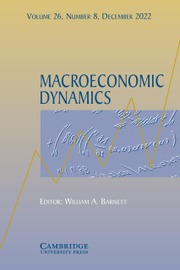No CrossRef data available.
Article contents
ASSET PRICING WITH BORROWING CONSTRAINTS AND EX ANTE HETEROGENEITY
Published online by Cambridge University Press: 02 March 2005
Extract
In answer to the question “Will borrowing constraints necessarilyintensify aggregate fluctuations and aggregate cyclical variability?” it has been found that complete markets equilibrium displaysaggregate fluctuations that may be dampened when borrowingconstraints are introduced. Like others, I find that variability inthe distribution of labor productivity shocks amplifies aggregatefluctuations. I also find that allowing agents to have differentpermanent incomes amplifies aggregate fluctuations, enriching theasset-pricing implications of the complete contingent claims modelwhen demand aggregation is not possible. Although agents are able toequalize their intertemporal marginal rates of substitution (IMRS) ofconsumption state-by-state, the IMRS of labor is not equalized acrossagents, creating gains from specialization. To determine howfrictions affect aggregate variability, two types of borrowingconstraints are studied. In the first model, dividend payments arerestricted and, in the second, nonhuman wealth is restricted to bepositive. Either type of borrowing constraint can dampen aggregatefluctuations.
Information
- Type
- Research Article
- Information
- Copyright
- © 1997 Cambridge University Press

